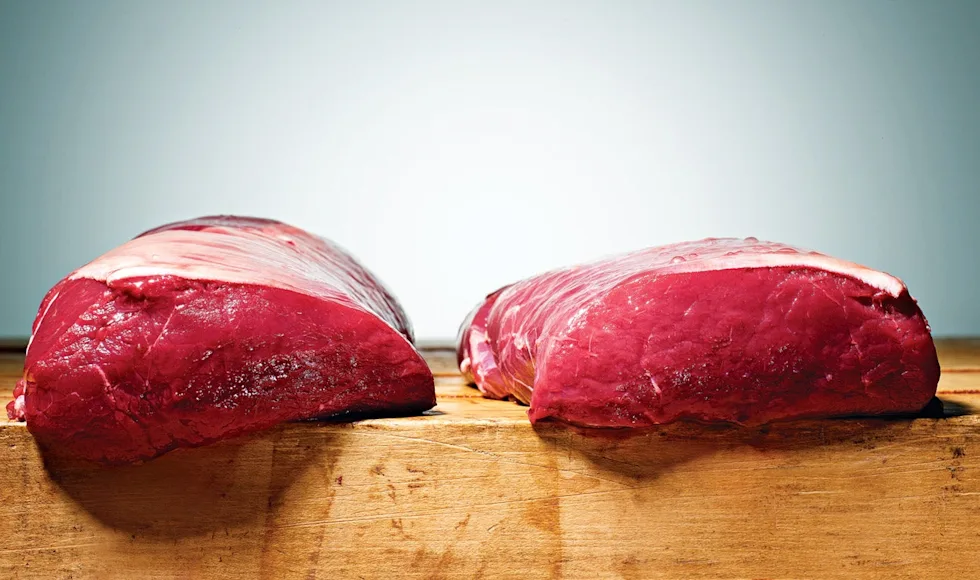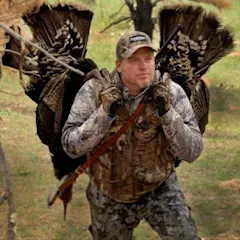We may earn revenue from the products available on this page and participate in affiliate programs. Learn more ›
_
Why should you learn how to butcher a deer by yourself? Because the venison will taste better. Professional butchers need to profit from their efforts, and that’s fine. But since time is money, most of them can’t afford to put the time and care into the job that you can in order to get the absolute best-tasting meat.
Besides, if field dressing is the last thing you do with a deer before the butcher hands you a box of white packages, you’re missing out on something: If you butcher the deer yourself—if you see the process all the way through, from lacing your boots to taking a forkful of venison—you’ll appreciate where your meat comes from in a way you may not have before. And did I mention that you enjoy the best-tasting venison you’ve ever had? So, let’s get to it. Below is a step-by-step guide for how to butcher a deer, from the moment you hang your buck on the meat pole to stacking packages of perfectly butchered venison in the freezer.
How to Butcher a Deer: Skinning
I hang my deer head-down from a gambrel for cooling and aging, which keeps the blood from draining into the best meat. And because I can’t think of a good reason to turn the thing around, I skin it that way, too. There’s no question that the sooner you skin a deer after shooting it, the easier the skin will come off. But you may need to hang your deer outside, in which case the skin protects the meat from the elements. Either way, the process is the same. So, here’s how to skin a deer in seven simple steps.
Related: How Long to Hang a Deer for the Tenderest Meat
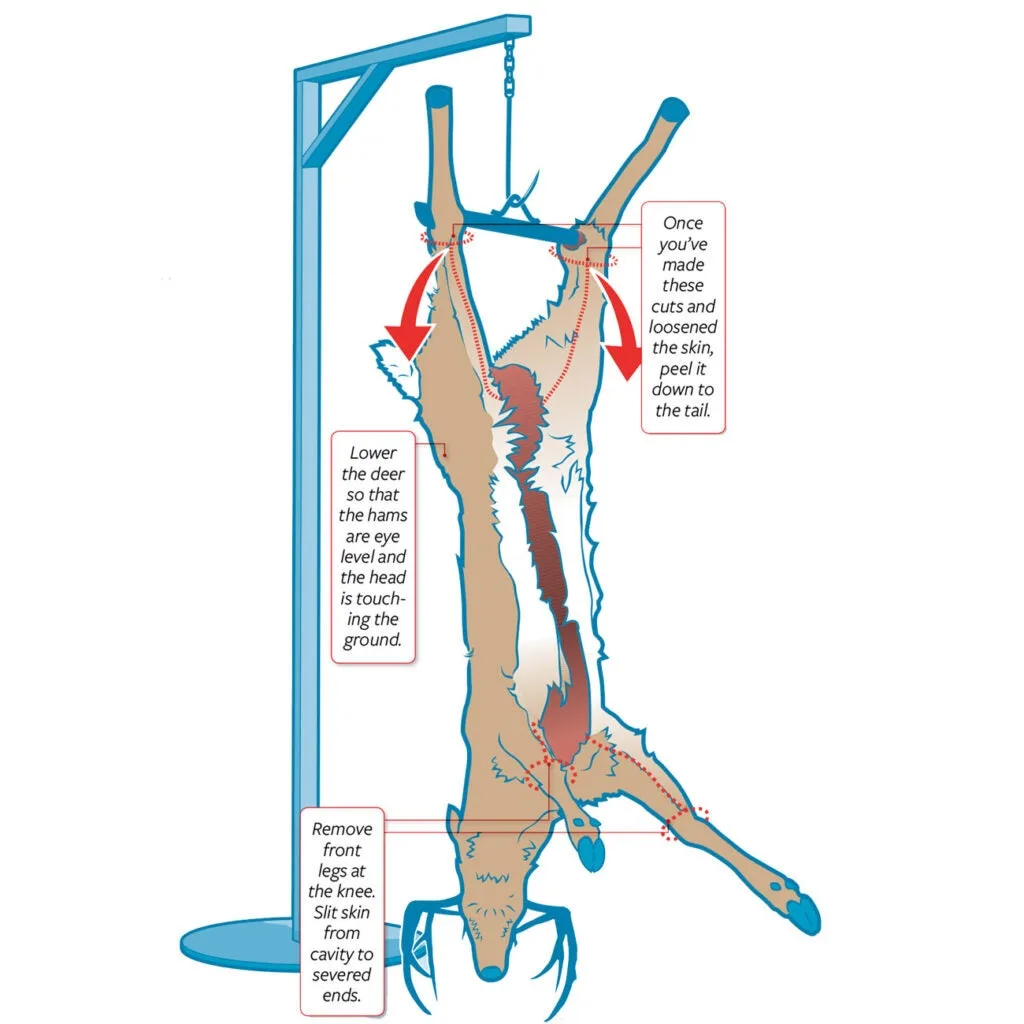
| Dan Marsiglio |
How to Skin a Deer, Step-By-Step
Step 1: Lower the carcass so the hams are roughly eye level and the head is touching the ground, which helps keep the critter from swinging around as you work.
Step 2: Starting at the groin, slip your knife’s point under the skin, blade up, and cut a long slit up from the bottom of one ham up to the knee. Repeat on the other side. (Do you best not to get a bunch of hair on the meat during this process, but there’s no need to obsess over it. You can rinse the meat and pat it dry after boning it out and before trimming it.)
Step 3: At the back knees, cut all the way around each joint being careful not to sever the tendon that holding each end of your gambrel. Grab and peel the skin off the back legs and down to the tail.
Step 4: Sever the tailbone and then keep peeling all the way down to the front shoulders, using your knife when necessary to help free the skin.
Step 5: Cut the front legs off at the knee. (A good bone saw or even sharp lopping shears are handy for this.)
Step 6: Starting at the chest opening, slip your knife under the skin and cut a long slit along the inside of each front leg to the severed end. (If you prefer, you can make this slit in the other direction, from the severed end up to the chest opening.) Peel the skin off the legs, then over the shoulders, then all the way down to the base of the neck, using your knife as necessary.
Step 7: Slice through the meat of the neck with a knife, and cut through the spine with a bone saw.
How to Butcher a Deer: Boning Out the Meat
Many processors offer bone-in cuts, but most do-it-yourselfers totally, or at least mostly, debone their meat. After many years of butchering lots of deer, here’s the process that works for me, broken out into six steps.
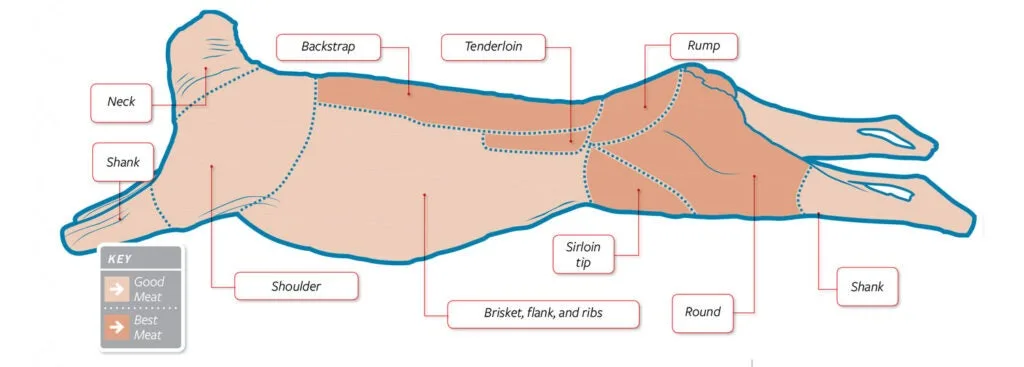
| Follow this cut chart to separate your venison into proper categories. Dan Marsiglio |
How to Bone Out a Deer, Step-by-Step
Step 1: Get two large, clean tubs or buckets. One is for meat we’ll categorize as Good—the tougher, fattier, more sinewy portions that will become burger, sausage, jerky, stew meat, and pot roast. (See the cut chart above.) And the second for Best—the larger, leaner, more tender cuts that make tasty steaks, dry roasts, and kabobs.
Step 2: Detach the front legs: Grab a shank, pull it slightly away from the body, and start slicing between the leg and the rib cage. Continue cutting around the leg, eventually between the shoulder blade and the back. If your knife is sharp, you’ll be shocked at how little attaches the front leg to the body. Repeat on the other side, and set both front legs aside.
Step 3: Remove neck meat, brisket, and flank and toss into the Good pan. Since this will most likely be ground into burger or sausage, it’s not important that you get it off in one nice piece. Hack it off as best as you can. (I know people who like neck roast, but I’m not one of them— although I will sometimes save a nice, piece of brisket or flank for carne asada.)
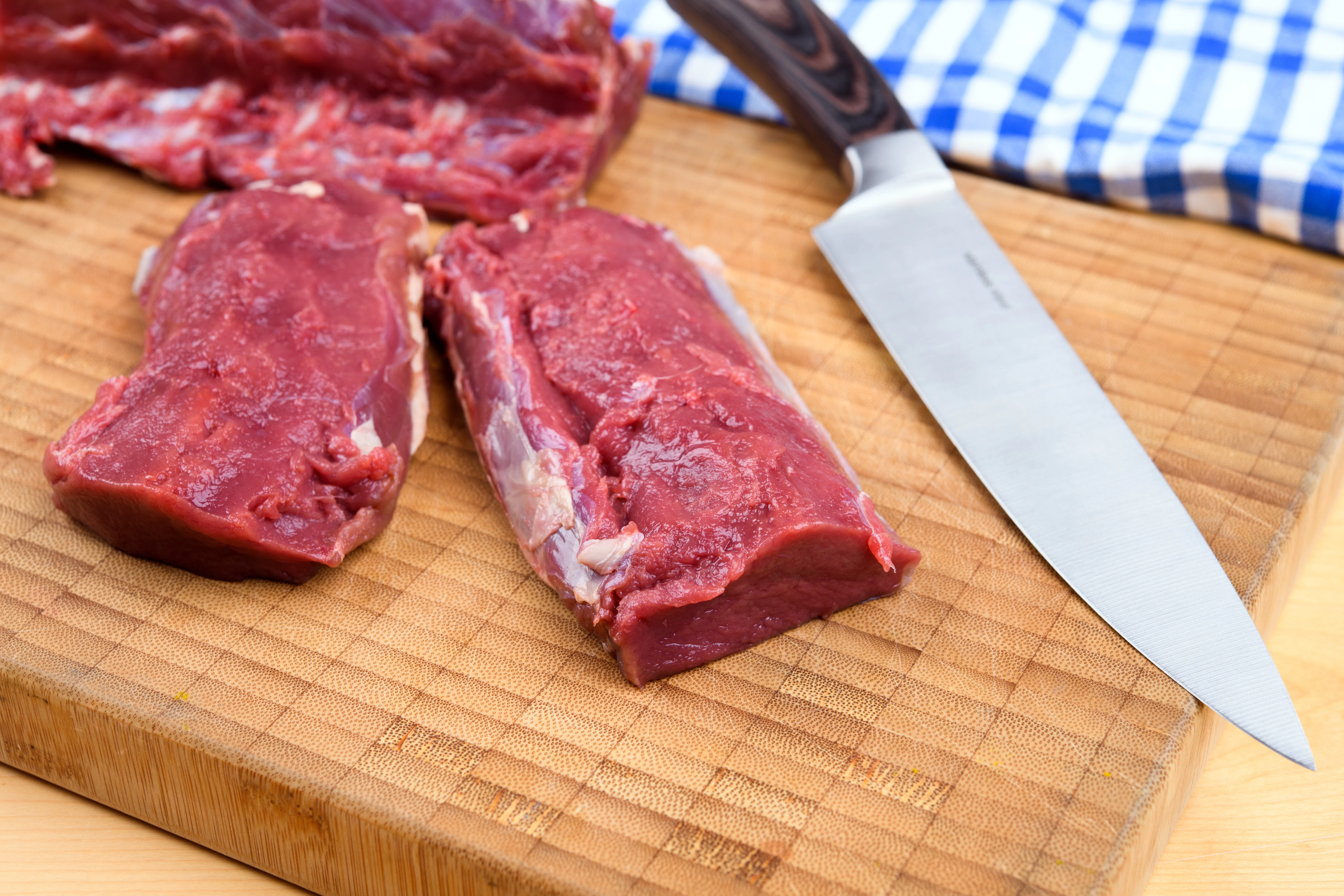
| Venison backstrap, cut into 10- to 12-inch chunks and ready for the freezer. Adobe Stock |
Step 4: Next, remove the backstraps. For each, cut two long slits from the rump to the base of the neck—one tight along the backbone, the other tight along the top of the ribs. Make a horizontal cut across these two slits at the base of the neck, and then lift the backstrap while scraping along the bone beneath with your knife to collect as much meat as possible. Toss into the Best pan.
(Note: If you prefer, you can remove the backstrap the other way—from the rump down to the neck—but I find that doing it as described above helps ensure that you get all of the best meat.)
Step 5: The hind quarters are easiest to debone if you remove them from the carcass and bring them to a table. Slice tight along the pelvis and hip bones to find the ball-and-socket joint, then work your knife into the joint to separate the ball from the socket and free the leg. At the table, start with the shank. I usually make bone-in shank cuts with a saw for osso buco, but as this is about how to bone out a deer, you can simply remove the shank meat off each hind leg with a knife and add to the Good pan. On the rest of the hindquarter, natural seams of silverskin run between large muscles. I find it easiest to first separate these muscles as much as possible by working wetted fingers into the seams. Then just cut the muscles off the bone to get clean, largely seamless hunks of meat, all of which should go in the Best pan.
Step 6: Now put the front shoulders on the table, remove the shank meat, and toss into the Good pan. The upper portion of each front shoulder does have some reasonably sinew-free meat that can be used for roasts or even steaks—just not very good roasts or steaks. I put this, as well as any remaining edible meat on the carcass, into the Good pan and use the best of it for stew meat and jerky. The rest gets ground for burger or sausage.
How to Butcher a Deer: Trimming
Many people feel that deer fat tastes nasty. If you’re one, trimming is the most important step in this entire process. It can spell the difference between mild, sweet-tasting meat and strong, possibly even sour meat. I, for one, don’t think deer fat tastes nasty as a rule, just a little stronger than, say, beef. So, I’ll tend to leave more fat than some. That said, I still think that doing a thorough job of trimming sinew, silver skin, connective tissue, and unwanted fat is vital for the best-tasting meat.
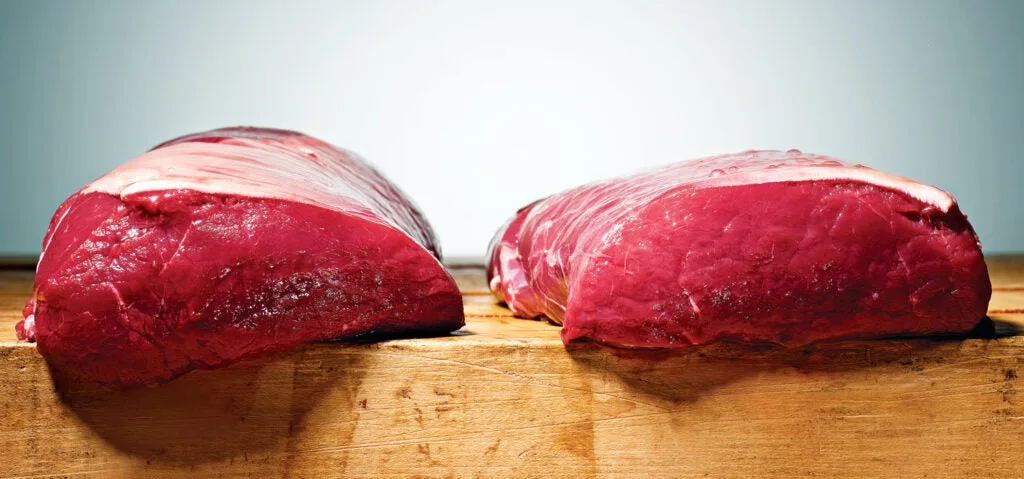
| Make sure you trim the silverskin from backstraps before you cook. Travis Rathbone |
How to Trim Venison, Step-by-Step
Step 1: Sharpen your fillet knife. Grab the Good pan, and take any piece of meat and assess it. It’s O.K. to have a touch of silverskin and some fat in what will become burger or sausage. But you want very little to none in your jerky and stew meat. So if the piece you’re holding can be easily trimmed into a small hunk of clean, lean meat, trim it and toss it into a pile designated for jerky or stew. If not, trim the unwanted fat and connective tissue as best you can and toss it into a second pile for burger and sausage.
Step 2: Now take your Best cuts and trim every last bit of connective tissue and unwanted fat from each. If you expect your venison to be in the freezer for longer than six months, leave the silverskin for now and trim it later, as it can help protect the meat from freezer burn. Otherwise, take it off.
Step 3: Cut into to large pieces. Slicing the backstrap and parts of the hindquarter into steaks now limits how you can prepare the meat later. Instead, cut the backstraps into 10- to 12-inch-long sections and leave the individual muscles and muscle groups of the hindquarter whole, and freeze it all like that. When you take a package out to thaw and cook, you’ll still have the option of making 1⁄4-inch-thick medallions, 1-inch-thick steaks, 5-inch-thick fillets, or whole roasts.
How to Make the Best Venison Burger
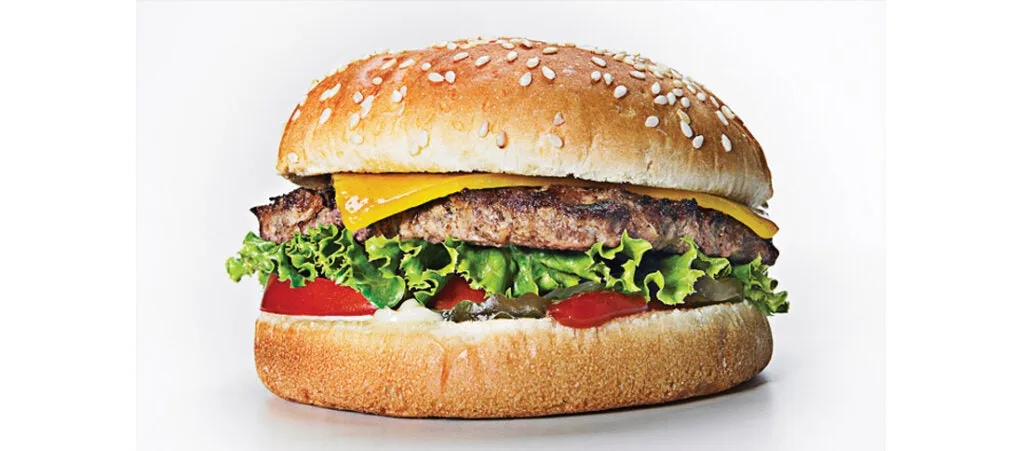
| Call your local butcher and ask them to set aside some beef fat. Dan Saelinger |
Because deer meat is so lean (especially if you meticulous about trimming), venison burger can be a bit dry, depending on how well-done you cook it. If that’s a concern, there’s a simple solution that only takes a phone call. Ring your local butcher (or the meat counter at the grocery store) and ask them to set aside some beef fat for you. Unlike venison fat, beef fat is mild-tasting. And unlike pork fat, it doesn’t prevent you from cooking your burger medium-rare. Grind in 1 to 1.5 pounds of beef fat per 10 pounds of meat, depending on how lean you like your burger.
RELATED: A New Way to Cut a Duck
The Tools You Need to Butcher Your Own Deer
Turning a deer into venison can be a pretty big job. How big, however, depends on how many tools you have and how good they are. Here are the things you need to butcher a deer, and the thing you don’t need but will make the process much easier.
1. Heavy Duty Meat Grinder
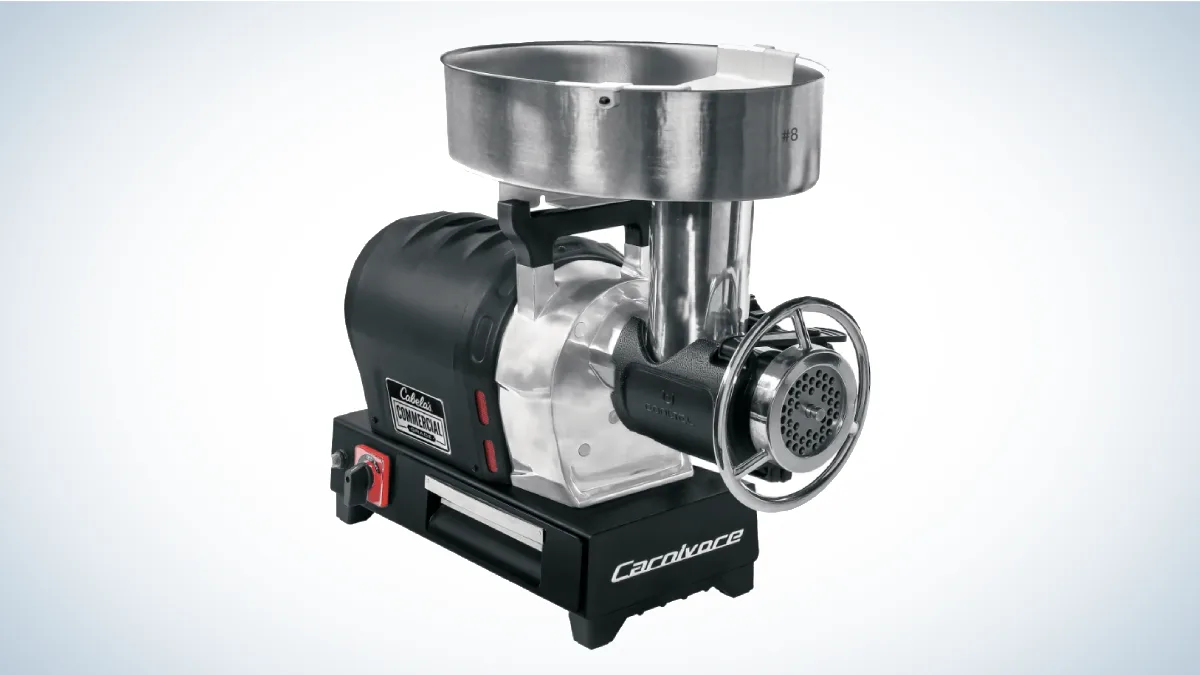
Hand grinders work. So do hand drills and hand butter churns. It’s just a question of how you want to spend your time. Cabela’s offers a line of excellent electric meat grinders from 400W to 1-3/4 horsepower (from about $130 to $700). If you plan to do a deer to two every year, I wouldn’t get anything less powerful and 1/2 a horse, preferable 3/4.
2. Electronic Cable Hoist
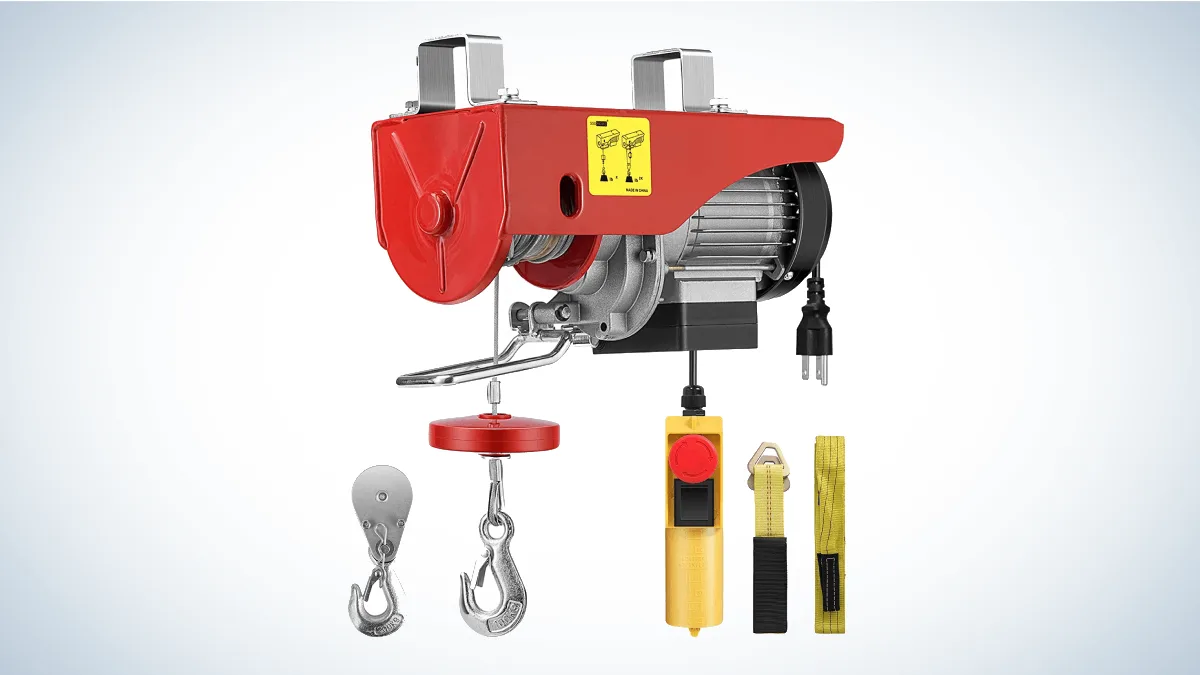
If you’re still young and full of beans, you don’t need this. If you’re not, you don’t need me to explain why you do.
3. Skinning Tool
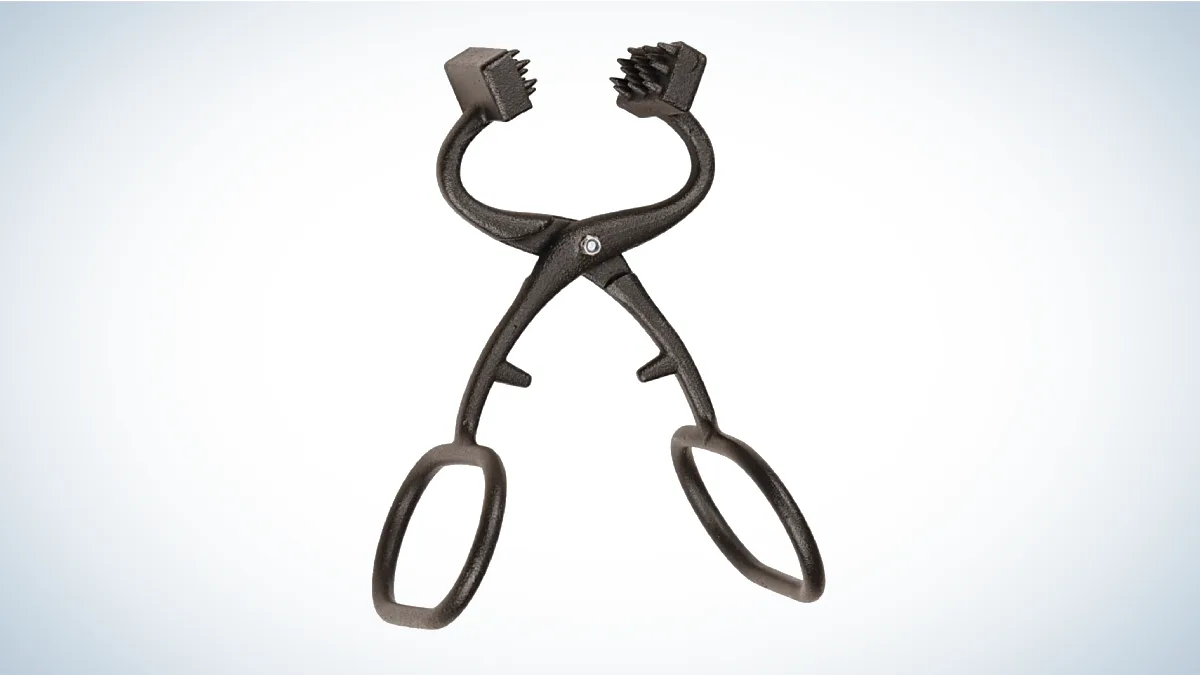
If you can’t get a grip on a slick deer hide, it’s because you don’t have this. The Big Game Treestands Deluxe Skinning Tool’s teeth bite into the skin and hold it fast so you can really rip—a big help.
4. Skinning Knife
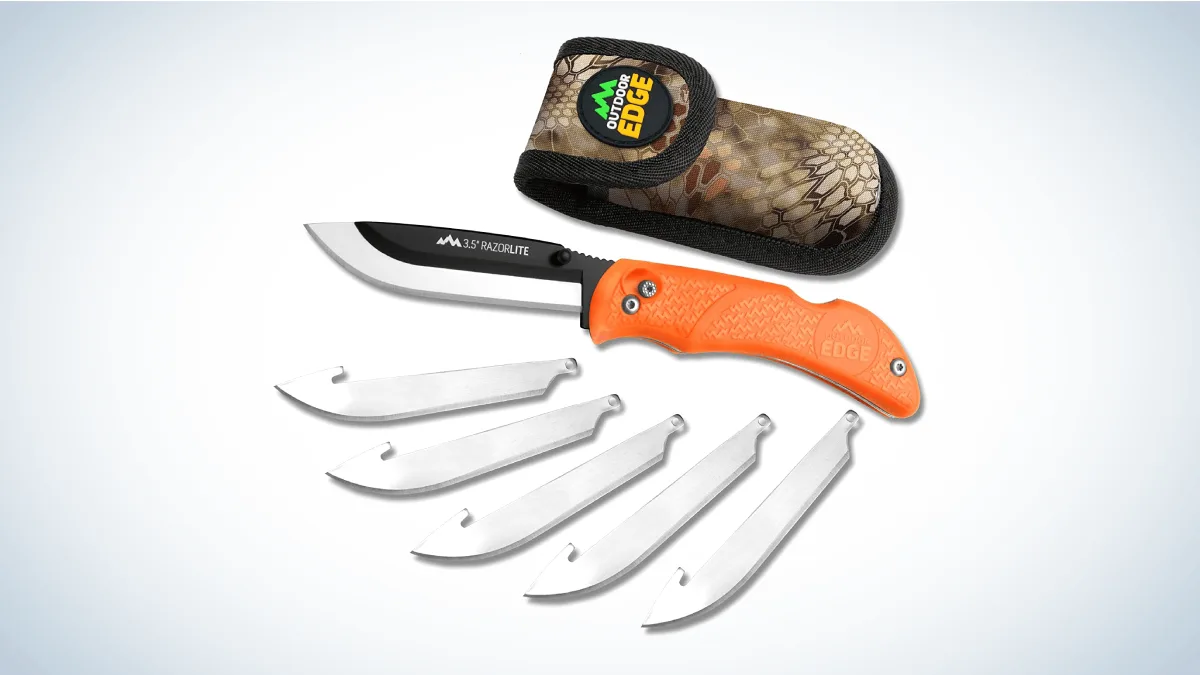
Any drop-point hunting knife can work just fine for skinning, but because the job dulls a blade quickly, it’s nice to have a replaceable-blade model, like the Outdoor Edge RazorLite.
5. Boning Knife
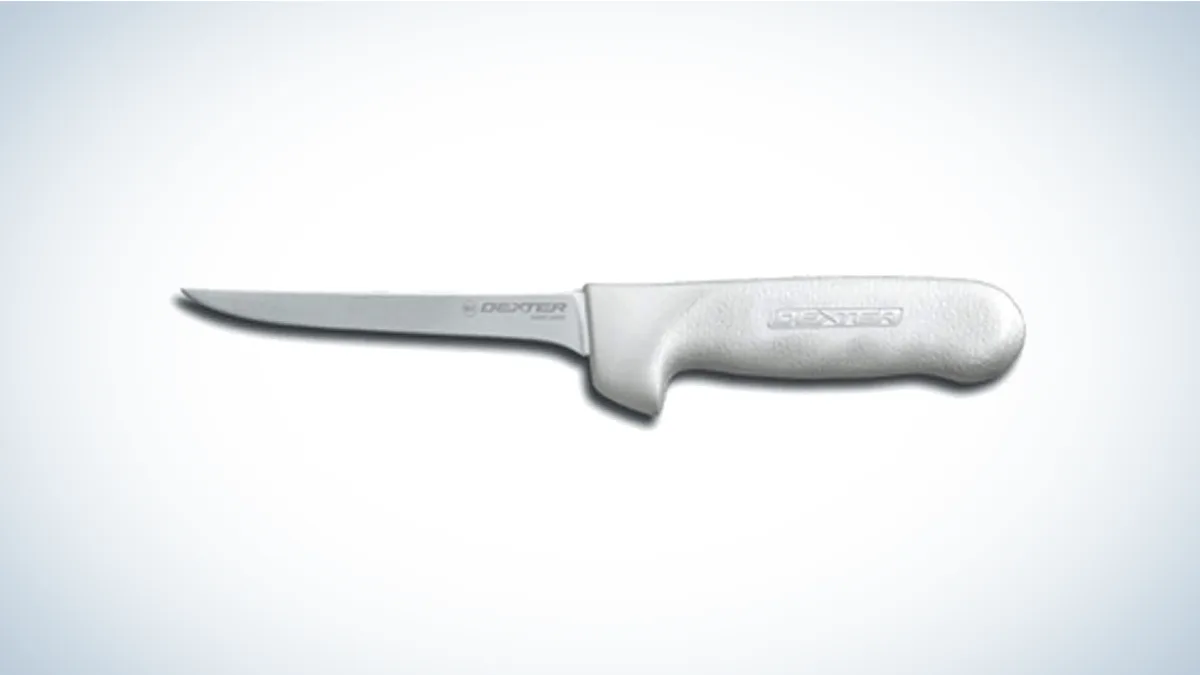
This will be your primary butchering knife. You want one with a handle that doesn’t get slick amid blood and slime. I like the blade to have some flex. For my money, this Dexter Russel 5-inch Narrow Boning Knife is just right and bargain, to boot. I’ve had mine for probably 20 years.
6. Meat Saw

As quality meat saw is a must if you plan to butcher your own deer as a regular thing. It’s perfect for zipping off legs or splitting a pelvis in no-time flat and for making any bone-in cuts you might like, like shank cuts for osso buco.
Frequently Asked Questions
How long should you let a deer hang before you butcher it?
Ideally, you should hang your deer for at least a day or two and preferably five days or more for older bucks. Rigor mortis, which sets in soon after death and lasts 12 to 24 hours, contracts and stiffens muscle tissue, making meat less tender. Butchering and freezing the meat before this is complete results in thaw rigor, better known as, “shoe leather.”
If you must butcher your deer right away because of high temperatures, bone it out and put the meat in a cooler or refrigerator for couple days or more before freezing.
How long after killing a deer is the meat good?
It all depends on the conditions. In a walk-in cooler kept at 36 degrees and low humidity, a deer could last, unspoiled, for 6 weeks or more. During an unseasonably warm spell in November, it could spoil in a couple days. Generally, if daytime temps are going to threaten 50 degrees, it’s best to go ahead and butcher the deer, or break it down and put it in a cooler.
How hard is it to butcher a deer?
Well, it isn’t exactly easy. It’s not like tying a Palomar knot or fletching an arrow. If you haven’t done it before, it’ll take you the better part of a day, maybe a little longer. If you do it a lot, you can bang it out is a few hours. So, it’s time-consuming and can be somewhat physically taxing if, like me, you’re not quite the man you used to be. But nothing about it is complicated or technically difficult. And almost anyone who does it will tell you that it’s worth the trouble.
Should you skin a deer right away?
In an ideal world, yes, you should skin a deer right away? For two reasons: First, your deer will cool faster, and, second, the skin will come off much, much easier than if you wait a day or two. So why doesn’t everyone do it this way? Also two reasons: (1) If you have to hang a deer outside, the hide protects it from the elements, especially moisture, which promotes bacteria growth; and (2) hanging a skinned deer for long periods creates a hard crust on the outside of the meat, which needs to be trimmed later and therefore costs you some meat. In the end, if it’s too warm out to hang your deer for any significant about of time, then you should skin it immediately. Otherwise, you have to weigh the pros and cons and decide for yourself.

